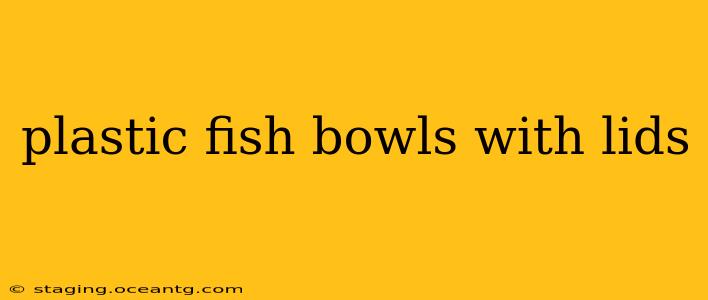Finding the perfect home for your aquatic friend can be tricky. While glass bowls offer a certain elegance, plastic fish bowls with lids provide a range of practical advantages, particularly for beginners or those with smaller spaces. This comprehensive guide explores the benefits, drawbacks, and considerations when choosing a plastic fish bowl with a lid. We'll also address some frequently asked questions to help you make an informed decision.
Why Choose a Plastic Fish Bowl with a Lid?
Plastic fish bowls offer several key benefits over their glass counterparts:
- Durability: Plastic is significantly more resistant to breakage than glass, making it a safer option, especially in households with children or pets. A dropped plastic bowl is far less likely to shatter and cause injury.
- Portability: Plastic bowls are lighter and easier to move than glass bowls, offering flexibility in placement and easier cleaning.
- Affordability: Generally, plastic fish bowls are less expensive than comparable glass options. This makes them a great choice for budget-conscious fish keepers.
- Variety: Plastic fish bowls come in a wider array of colors, shapes, and sizes compared to glass bowls, allowing for greater personalization.
- Lid Functionality: The lid offers crucial benefits, preventing fish from jumping out and reducing evaporation. Some lids even include feeding holes or ventilation.
What are the Disadvantages of Plastic Fish Bowls with Lids?
While plastic bowls offer numerous advantages, it's important to acknowledge their limitations:
- Scratching: Plastic bowls can be easily scratched, affecting their aesthetic appeal and potentially harboring bacteria.
- Chemical Leaching: Low-quality plastics may leach chemicals into the water, potentially harming your fish. Always choose a bowl made from food-safe plastic.
- Limited Size: Large plastic bowls are less common and can be more expensive than smaller ones. This restricts the size and type of fish you can keep.
- Less Clear Visibility: Plastic can sometimes distort the view of the fish and the interior of the bowl compared to clear glass.
What Size Plastic Fish Bowl Should I Get?
The size of the fish bowl depends entirely on the type and number of fish you intend to keep. Never choose a bowl based on the fish's current size; consider its adult size. Overcrowding is a major cause of stress and illness in fish. Research the specific needs of your chosen fish species to determine the minimum tank size requirements. Remember, even with a lid, a small bowl will still restrict water quality and create a stressful environment for your aquatic pet. Larger tanks, while perhaps not plastic, are generally better for fish health.
Are Plastic Fish Bowls with Lids Suitable for All Fish?
No. Plastic fish bowls with lids, even larger ones, are generally unsuitable for most fish species. Many fish require significantly more space and filtration than a bowl can provide. They are best suited for small, hardy fish with low activity levels that require minimal water filtration. Betta fish (Siamese fighting fish) are sometimes kept in bowls, though larger tanks are always preferred.
How Often Should I Clean a Plastic Fish Bowl with a Lid?
Regular cleaning is crucial to maintaining good water quality. You should partially change the water (around 25%) weekly and perform a thorough cleaning (including scrubbing the bowl) monthly. Avoid using harsh chemicals, opting instead for fish-safe water conditioners and cleaning solutions.
Can I Use a Plastic Fish Bowl with a Lid for a Beta Fish?
While Betta fish are often kept in small bowls, it's important to emphasize that larger tanks are significantly better for their health and well-being. A larger tank provides more space for swimming, better water quality, and reduces stress. If you use a bowl, frequent water changes are essential.
What materials should I avoid?
Avoid bowls made from plastics that are not specifically labeled as food-safe. Look for clear labeling that indicates suitability for use with food or beverages. Cheap plastics may leach harmful chemicals, harming your fish.
Choosing the right home for your fish is a significant step in responsible pet ownership. While plastic fish bowls with lids can be a suitable option for certain fish and situations, careful consideration of the fish's needs, the bowl's size, and water quality maintenance is paramount. Always prioritize your pet's well-being.
